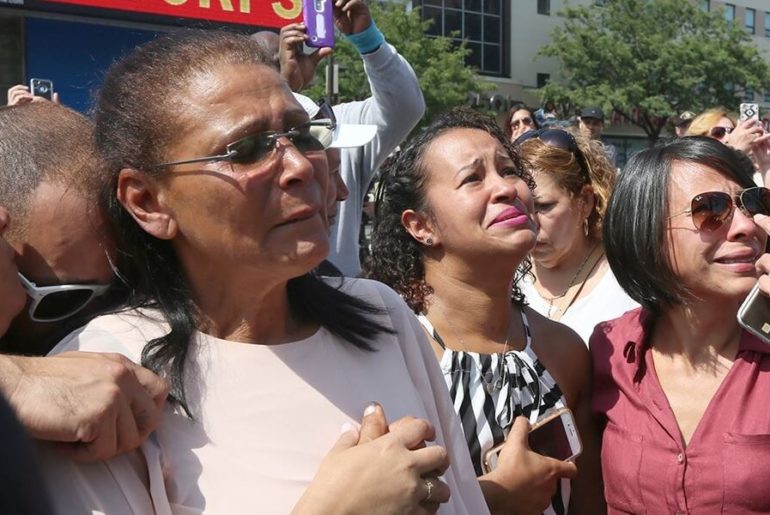Sean Monterrosa was a fairly typical 22-year-old. He loved drawing, boxing and skateboarding. He was close with his family and even talked about making enough money to buy his mom a house. That promise was never fulfilled. On June 2, 2020, Monterrosa was shot and killed by a Vallejo, California Police officer as he was exiting a store.
“My brother was kneeling and surrendering, yet you shot my brother from your vehicle through your windshield,” Monterrosa’s sister, Michelle Monterrosa, said to the officer. “How much more cowardly can you be?”
Four days later, another young Latino man, 23-year-old Erik Salgado was shot and killed by a police officer. The officer also injured Salgado’s pregnant girlfriend. Both Salgado and Monterrosa were unarmed at the time of their deaths, victims of police brutality.
For the past two weeks, thousands have taken to the streets of the U.S. to protest against police brutality against Black Americans. However, much like their Black bothers, Latinx men experience significant police discrimination.
According to the U.S. Bureau of Justice Statistics, Hispanics make up 17.6 percent of the U.S. population but represent 23 percent of all police searches and nearly 30 percent of arrests. Just in California, where Monterrosa died, Latinos made up 39 percent of the population but represented 46 percent of deadly police shootings between 2016 and 2018, according to an analysis by CalMatters.
And it doesn’t stop there.
Even though Black and Brown Americans make up 31% of America’s population, they make about 56% of the incarcerated population. Additionally, the U.S. is known to have one of the largest prison populations, where Blacks and Hispanics spend a disproportionate time in solitary confinement.
According to several studies, the impact of police brutality has long-lasting effects on Latinx communities and their children, who often present Post Traumatic Stress Disorder (PTSD). Accoridng to one of the studies, “once racial discrimination is experienced, children develop perceptions of threat, fear, victimization, low self-efficacy, low self-esteem, and hopelessness, which then lead to problems with depression, anxiety, and anger.”
So, why don’t we hear about this more often?
“There’s lots of challenges in reporting cases for the Latino community in particular, because of questions around identity. We just don’t have enough information to document all the cases that are occurring, certainly not by race and ethnicity,” Eric Rodriquez, vice president of the NCLR’s office of research, told PBS. “But there’s a recognition more broadly that deaths at the hands of law enforcement are having too many racialized outcomes.”
Rodriguez told the media that part of the reason police aggression towards the Latinx population is not well-documented is because a lot of the figures come from self-reported statistics from local and state agencies. This happens because a lot of times a victim’s race may not be disclosed at all during a transgression.
Additionally, a big part of the national detention rates of Hispanics, according to Rodriguez, is linked with immigration enforcement. Therefore, police transgressions might be written off as immigration procedures and downplayed to a certain degree. This has to do in big part with the lack of American education on the extensive fight of Latinos in the U.S. for civil rights.
“In American history, racial conflict has largely played out in black and white. But the history is much more complicated, [leaving] out Native Americans, as well as Asians and Hispanics,” Aaron Fountain, historian of youth activism at Indiana University told PBS. “Americans don’t see any kind of historical context when Latinos are victims of state violence, despite the fact that there is historical context there.”
This history includes a long documented chain of abuse against Latinx people, particularly in the West, where Latino lynchings were common occurrences and racial segregation and discrimination typical. It all goes back to when the U.S. acquired 55 percent of Mexican territory as a result of their victory in the Mexican-American War of 1848. At the end of the war residents of that area were nationalized as American citizens, becoming the first Mexican population to live in the U.S.
This acquisition of land by the U.S. resulted in more migration from the Hispanic country to the U.S., whose economy greatly benefitted from the arrival of Mexican workers. However, it wasn’t long until segregation started, with English-speaking entities denying entry to Hispanic people and separating their communities.
As the 19th century wore on, the interactions started becoming more violent, making public lynchings and mob killing a common occurrence. During the early start of the 20th century, Hispanics suffered many agressions including school segregation for their children and periods of mass deportations which would go on to occur throughout the end of the century.
How Can You Help?
There are several organizations that are taking the lead in addressing police brutality in Latinx communities. These include Love Resists, Georgia Latino Alliance for Human Rights (GLAHR), UnidosUS, and more. You can also support politicians who are fighting for a fairer justice system for Latinx immigrants, like Congresswoman Ayanna Pressley. Congresswoman Pressley has been trying to pass The People’s Justice Guarantee, which aims to alter the justice system so it doesn’t disproportionately target minorities.
If you want to help the families of Sean Monterrosa and Erik Salgado you can donate to their families’ GoFundMe pages here and here. Finally, joining The Black Lives Matter Movement is another active way in which you can support Latinx communities and demand justice for minorities being mistreated by police.
“The movement for black lives is doing something important, elevating all minority lives. And that’s a critical part of the solution,” Rodriguez says. “But if our response is narrow and limited, the national response will be narrow and limited as well. And that’s problematic as we move toward a country that is increasingly diverse.”

